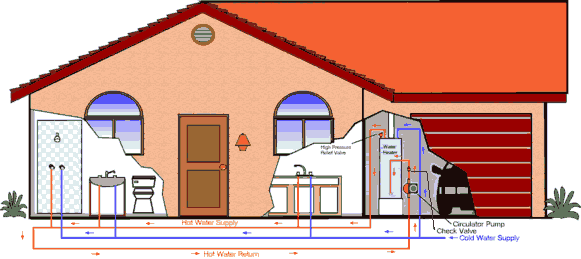Hot Water Recirculation- How It Works
A return line is installed near the faucet farthest from the water heater. The return line is connected to the UP 15 series pump and flows back to the water heater. As water slowly cools in the hot water line, the UP 15 series recirculation pump then moves the hot water from the heater throughout the pipe back to the heater, creating a continuous loop of slow-moving warm water. When a faucet is turned on, warm water is instantly available for use with no waste.
Every homeowner gets frustrated waiting for hot water -- but how many stop to think what happens to the 2-3 gallons of water that runs down the drain during the wait? Those gallons of water are wasted, and in an average household that takes four showers per day, that can add up to thousands of gallons per year. Multiplied over a subdivision of 300 homes, a community can have millions of gallons of water go down the drain and into the wastewater system every single year. In a region where water conservation issues are rising in importance with a rapidly expanding population, and a record economic expansion that has consumers looking for comfort, Hot Water Recirculation (HWR) pumps -- such as those manufactured by Grundfos Pumps Corporation -- are a good solution to this problem. In typical plumbing, water is pumped from the water heater through the pipes to the tap. Once the tap is shut off, the water remaining in the pipes cools -- hence the familiar wait for hot water the next time the tap is opened. CF Plumbing offers Grundfos hot water recirculation pumps, which are a solution to the problem by attaching to the water heater through the hot water pipe. By constantly circulating hot water through the pipes from the heater to the furthest fixture, the water in the pipes is always hot, and no water is wasted during the wait.

















